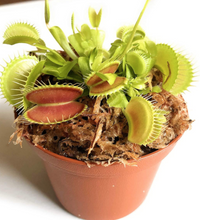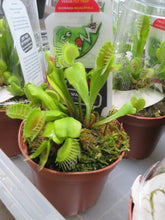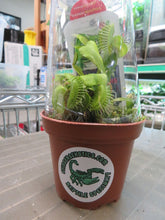Life Cycle of the Venus Flytrap:
Year 1: Tiny seedlings emerge, their first two leaves are very small green petioles that will push the plant out of the seed and into the growing medium. Next tiny trap leaves will appear, fully functional despite their size of 1-2mm. The entire plant will rarely get larger than a penny the first year.
Year 2: After the first dormancy the tiny plants will perform pretty much just like their larger relatives. Traps will reach up to 3/8 of an inch, and the plant will grow to an inch or so across.
Year 3: Getting larger still with traps up to 1/2", now capable of catching something larger than a soil gnat. Third-year plants will get to be a couple inches tall, and some more robust plants may even flower.
Year 4-5-6: Plants are now considered mature and will flower each season and can self-pollinate to produce seed. These may also start to split beneath the soil level and can be separated and repotted. Leaf cuttings may be taken to achieve more plants.
Additional Care Information for Venus Flytraps:
The most important things to avoid:
1. Excessive heat. Keep indoor and especially domed or terrarium grown plants out of direct hot sun.
2. Low humidity. Keep well above 50%. If you live in a dry climate, you will not be able to grow these without a terrarium or humid enclosure.
3. Keeping your Venus Flytraps too wet for the amount of light it is getting. Plants that are kept too wet may rot. During the summer when kept outdoors, they can be kept very wet. Indoors they will require less water, but never let them dry out.
4. Excessive handling. As much as they may seem like pets, the more you handle them the more stressed they will be.
Those that are showing signs of stress are not necessarily doomed. They grow from bulbs, which store a lot of energy for the plant. Leaves that have blackened and died are only leaves and the plant can grow more as long as the bulb is healthy. The bulb should be a creamy white color. If the plant is really having a hard time, un-pot it and check for fungus or any rotting that may be occurring for various reasons. Dust the bulb with a fungicide and re-plant it. Even if most of the rest of the plant has died back, the bulb can still produce new growth. Some plants will die back quite a bit while acclimating to new conditions. Never give up on a Venus Flytraps plant until you are sure that the bulb has completely turned to mush.
Year 7-8, beyond: Venus Flytraps will live as long as they are kept in proper conditions. They will sometimes form monster bulbs the size of a golf ball or larger, producing traps well over 1" on larger leaves. Sometimes the plants will continue to split and divide, producing many larger sized bulbs each year.
Sold out until next Spring! These are seasonal for us... check with us in 2026 or watch this page!
Understanding Venus Fly Traps





